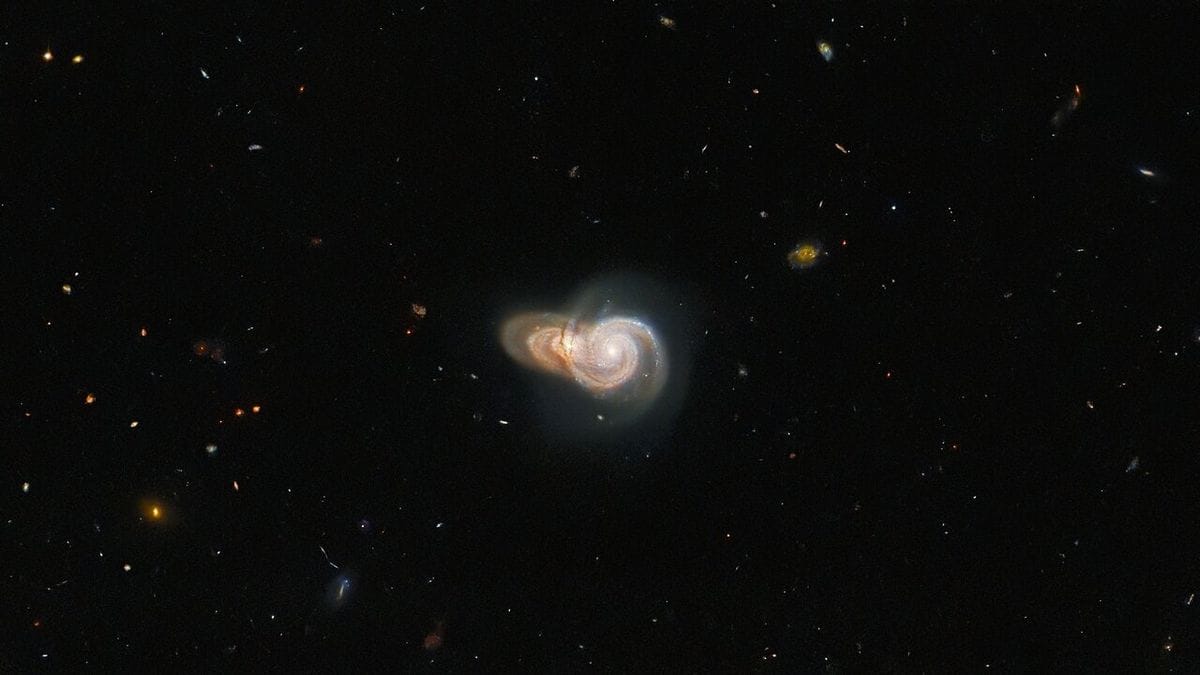In a groundbreaking revelation, astronomers utilizing NASA’s Hubble Space Telescope have unveiled a celestial marvel—a galaxy with a record-breaking nine concentric rings. Officially named LEDA 1313424 yet colloquially dubbed as the “Bullseye,” this gigantic galaxy is unique in its formation, offering a rare glimpse into the intricate dynamics of intergalactic collisions. This astronomical feat has ignited intrigue and admiration in the scientific community while also paving new avenues for space exploration.
The galaxy, located approximately 300 million light-years from Earth, resides in the constellation of Leo. Its colossal structure spans a staggering 250,000 light-years, dwarfing our Milky Way galaxy by more than double its size. The “Bullseye” earned its nickname due to its uncanny resemblance to a dartboard, a metaphor that aptly encapsulates the events that led to its unique configuration.
The nine rings of LEDA 1313424 materialized as a direct result of a dramatic cosmic interaction that occurred nearly 50 million years ago. A smaller blue dwarf galaxy, described as a “cosmic dart,” collided directly with the Bullseye’s core at high speed, passing through its epicenter. This monumental impact disrupted the gravitational forces of the larger galaxy, creating waves of ripples that formed concentric rings. Much like the widening circles created when a stone is dropped into a pond, these rings represent waves of star formation triggered by the collision.
The Hubble Space Telescope, along with subsequent observations from the Keck Observatory in Hawaii, meticulously captured the galaxy’s intricate features. Eight of the nine rings were visible in stunning detail through Hubble’s imaging systems, while the outermost ring required additional confirmation via advanced ground-based observatories. This achievement marks a milestone in the capabilities of current astronomical technology, manifesting in the precise capture of a phenomenon that might have otherwise gone undetected.
The smaller galaxy responsible for this celestial bullseye is visible in the images as well, positioned to the left of the Bullseye’s core. Its journey through the larger galaxy’s midsection is analogous to a dart piercing the very center of a target. Though relatively diminutive in stature, this blue dwarf galaxy set off a chain reaction of events that resulted in the creation of some of the most remarkable cosmic features observed in contemporary astronomy.
The Bullseye’s unusual structure not only captivates astronomers but also holds significant scientific implications. The rings are more than just visual spectacles; they provide valuable insight into the mechanics of galactic evolution. Each ripple or ring reflects a distinct phase of stellar creation, enabling researchers to study the timeline and intensity of star formation triggered by intergalactic disturbances. Moreover, the discovery sheds light on the interaction dynamics between galaxies of different sizes, helping astronomers better understand the cyclical processes governing cosmic structures.
Scientifically, the Bullseye galaxy challenges existing theories about the formation of ring galaxies. Prior to this discovery, the number of consecutive rings in any known galaxy seldom exceeded one or two. To find a galaxy adorned with nine distinct rings is unprecedented, raising questions about the frequency and conditions required for such phenomena. The event also highlights the role of smaller galaxies, which, despite their size, can profoundly influence larger systems through gravitational interactions.
LEDA 1313424’s discovery emphasizes the enduring relevance of the Hubble Space Telescope, even years into its operation. Launched in 1990, Hubble remains one of NASA’s most iconic and effective scientific tools. Images like those of the Bullseye showcase the telescope’s ability to delve into the intricacies of the universe, consistently broadening our understanding of space.
Looking forward, astronomers anticipate further investigations into the Bullseye and its neighboring galaxies. These observations may uncover additional evidence of past galactic interactions or even provide clues about the future trajectory of these celestial bodies. The advent of more powerful instruments, such as the James Webb Space Telescope, could also contribute to unearthing hidden details about this spectacle.
Ultimately, the Bullseye galaxy presents an awe-inspiring testament to the complexity and grandeur of the universe. It symbolizes the intersection of scientific inquiry and the boundless mysteries of space. Discoveries like these not only fuel scientific curiosity but also inspire a sense of wonder, inviting humanity to ponder its place among the stars.



